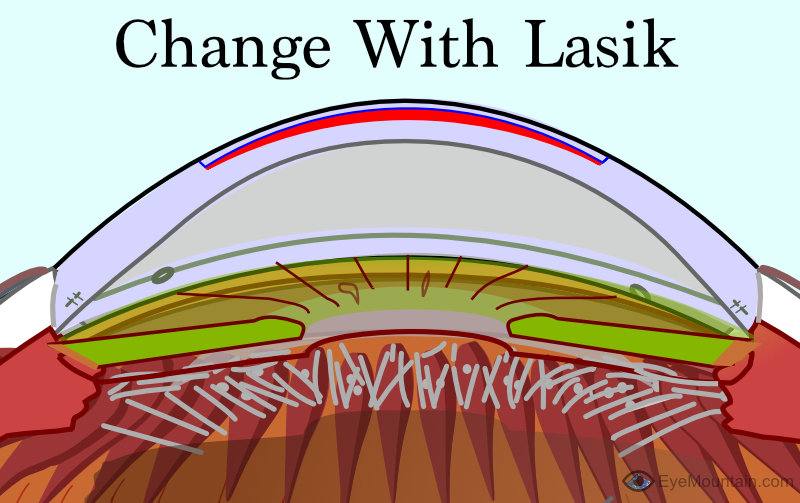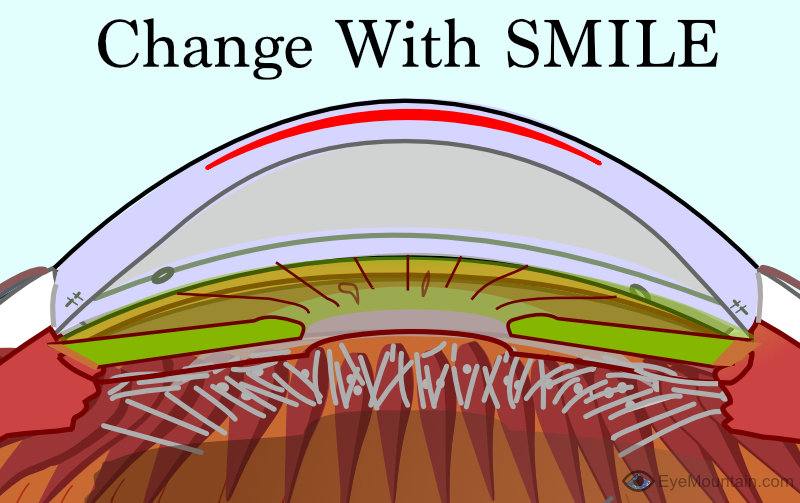SMILE eye surgery can get you out of glasses and contact lenses. That of course can make you smile. But beyond just the fun name, SMILE is one of the latest innovations in laser eye surgery.
Having your vision corrected with SMILE is very similar to having it corrected with lasik. They are both quick procedures with minimal recovery and downtime. However, there is one key difference: unlike lasik, SMILE avoids making a permanent flap within the cornea. SMILE instead corrects vision from within the cornea itself.
This differences comes with some significant benefits. So let’s see how SMILE is done and how well it works to get you out of glasses and contact lenses.
After learning more about SMILE eye surgery here, check out The Definitive Comparison of SMILE vs Lasik to learn how it compares to one of the most popular ways of using lasers to correct vision.
How SMILE Eye Surgery Works
When use use our eyes to look out and see the world around us, light passes through our cornea and then through our lens before finally coming into focus onto the retina onto the back of the eye. Both the cornea and lens work to focus this light so that what we see isn't all blurry.
But this focusing isn't perfect for everyone. Some people will still have blurry vision and requires glasses or contact lenses in order to make up for the deficiency of the cornea and the lens.
What makes vision blurry
For people who are nearsighted, the cornea focuses light TOO much. Vision will actually come into focus BEFORE reaching the retina. By the time it reaches the retina, vision has come out of focus again.
Light not focusing properly in nearsighted eye; graphic by Gumenyuk I.S., CC BY-SA 3.0, via Wikimedia Commons / cropped from original
But if we make the cornea less powerful and focus light less, we can allow vision to focus properly onto the retina.
Let's see how we can change the cornea to become less powerful by understanding the following diagram.
Calculating the focusing power of a lens; image by KDS444, CC BY-SA 3.0, via Wikimedia Commons
Just kidding, we won't need to know all that. Just note that there is some pretty sophisticated physics at play here.
The big summary here is that the steeper the cornea is, the more powerful it is. So to make the cornea less powerful, we want to make it less steep. We want to flatten it more.
Correcting blurry vision with lasers
SMILE is used to flatten the cornea more.
Lasik and PRK do the same thing. For nearsighted prescriptions, lasik and PRK work to flatten the cornea. The way it does it, however, is different from how SMILE achieves that goal.
A type of laser called a excimer laser is used during PRK and lasik. When this laser is applied to the rigid structural part of the cornea (called the stroma), this laser removes a very predictable amount of that cornea tissue. By removing more cornea tissue from the steep center part, the cornea becomes flatter.

Flattening of cornea from lasik treatment. Lasik flap is in blue, cornea removed with treatment is in red; cornea graphic courtesy of Jmarchn, CC BY-SA 3.0, via Wikimedia Commons
SMILE utilizes a different type of laser called a femtosecond laser. The femtosecond laser works differently than the excimer laser. Each pulse of this laser creates a microscopic air bubble pocket. By itself nothing remarkable, but when chaining these pulses together, we are capable of connecting these pockets together to create detailed 3D shapes. Very useful!
So useful in fact that the femtosecond laser already has a lot of use in ophthalmology. The laser that creates the lasik flap? You guessed it. A femtosecond laser. This laser is also used during cataract surgery to facilitate the removal of the cataract and for other eye surgeries. So we already have a lot of experience with this laser technology.
SMILE eye surgery uses the femtosecond laser to create the shape of a disc or lens WITHIN the cornea. A small tunnel is then created allowing the SMILE eye surgeon to access and remove this disc.
This disc isn't uniform however (if it was, that would leave the cornea exactly as steep as how it started). The disc is thicker within the center. Thus, when the disc is removed, the cornea becomes flatter and vision is corrected!

Shape of the SMILE disc created within the cornea; cornea graphic courtesy of Jmarchn, CC BY-SA 3.0, via Wikimedia Commons
Did you know SMILE was an acronym? Well, do you now. SMILE stands for SMall-Incision Lenticle Extraction. A lenticle (the disc or lens created) is extracted through a small-incision (the tunnel created by the laser).
Cool! But Why Bother?
Lasik and PRK already work well to correct vision. Why does SMILE eye surgery matter?
SMILE was created to solve a few issues with Lasik and PRK.
Our cornea is the most sensitive part of our body. Nerves run all throughout our cornea and especially near the front and surface of our cornea. These nerves are crucial to helping us keep an ample protective layer of tears on the surface of our eye; keeping our eyes feeling good and are vision clear.
Lasik and PRK both impair the function of these nerves.
- The edges of the lasik flap cut through these nerves.
- The PRK treatment travels through a dense network of these nerves concentrated just underneath the surface of the eye.
These nerves regrow, it just takes a long time. In the meantime, the eye is unable to protect itself from drying out. You develop an increase in dry eye.
Because SMILE happens at a decent level beneath the surface of the cornea, it spares a lot of these nerves. This means less dry eye.
Some may also consider SMILE less invasive than lasik because it does all this without needing to create a permanent flap within the cornea.
So yeah, not only is it a pretty cool way to correct vision, it actually has some benefits over other laser eye surgeries. Again, check out The Definitive Comparison of SMILE vs Lasik for the full rundown between the two technologies.
Procedure and Recovery
Having SMILE eye surgery only takes about 10 to 15 minutes. The procedure is done in office and you go home that same day.
For the first few hours after SMILE, it is common to have some amount of eye discomfort (from the scratch created by the tunnel). Fortunately, this goes away quickly.
Vision improves quickly. The next day you are able to see things well enough, but it can take a week or more for it to reach its full potential.
And while SMILE is designed to have less dry eye than the other laser eye surgeries, you can still notice some amount for the first few months.
Overall a very quick and easy treatment with a quick recovery.
The Results
SMILE corrects vision as good as we expect a modern laser eye surgery to correct vision. (It really is amazing how precise lasers can be at causing microns of change).
After SMILE surgery, more than 95% end up with perfect 20/20 vision without glasses.
The treatment lasts as well. It is very unusual for the treatment to regress or wear off. Nearly all will have the same vision 10 years out from SMILE as they had in the first year.
SMILE eye surgery is just as effective at correcting vision as the alternatives.
Who Is Eligible For SMILE Eye Surgery?
Thinking about SMILE? Well, first off, you have to meet a few certain criteria; but fortunately, this criteria isn’t too limited.
- Having a stable prescription. This also means being above the age of 18 and waiting for your prescription to stabilize. This is important for any corrective procedure; if your prescription is changing, laser eye surgery can’t provide a good long term correction. Check out Exactly When Does Vision Stop Changing to learn more.
- SMILE is only available for those with nearsighted prescriptions. Can see things up close but have trouble seeing things far off in the distance? You have a nearsighted prescription. SMILE can treat up to -10.00 of nearsighted prescription.
- SMILE can also treat your astigmatism. But only up to 3.00 of astigmatism. If you have significantly more than that, another laser eye surgery procedure may be preferred for you.
- If your cornea is too thin or has an irregular shape, it can make it more risky to correct your vision with SMILE.
- In addition, there are other conditions such as dry eye or other eye disease which can affect your ability to have SMILE eye surgery or other laser eye surgery procedures. Check out Learn Exactly Who Should Not Have Laser Eye Surgery for an overview of everything.
Summary
SMILE eye surgery is an innovative vision correction procedure. A laser is used to create a small disc within the cornea. This disc is then removed to flatten and reshape the cornea to correct vision. It is a very effective and successful procedure and provides a great alternative to other laser eye surgeries such as lasik and PRK.
Like what you just read? Use Social Media?
Stay connected and join the discussion by following Eye Mountain on
Also Check Out: